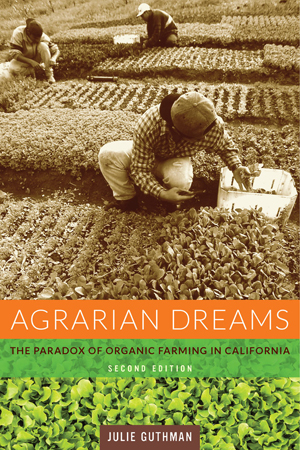Ten years ago, UC Santa Cruz professor Julie Guthman's book Agrarian Dreams: The Paradox of Organic Farming in California, was hailed as precedent setting, the first social science study of organic foods in the United States.
A lot has happened in a decade. Sixty percent of consumers now say they buy organics at least occasionally. Most supermarkets feature an organics section or private label for organics. For a while organic sales grew at a 20 percent a year clip.
In a new second edition just published (University of California Press) Guthman, a professor of social sciences and UC Santa Cruz alumna (Kresge, '79, sociology), takes a new look at the state of the organic food movement and some of the strange puzzles that afflict it.
"We've seen the increased legitimacy of organics in the policy arena," Guthman said. "Many conventional growers talk about trying organics or have even converted some acreage to organics. They may be doing it solely for market demand, but they no longer see it as this this weird fringe movement."
But along with political and market acceptance have come some contradictions and restrictions on further growth. Some niches are successful while others areas are more marginal.
For one thing growth has slowed to 7 percent per year and the percentage of land in the U.S. devoted to organic production is still tiny–about 1 percent–compared with conventional agriculture. Many growers go into organics and then get out again depending on market conditions.
This happened during the 2008-2009 recession, Guthman says, and "really speaks to the vulnerability of the organic industry to economic downturns."
Guthman has updated her second edition of Agrarian Dreams and added a new chapter eight: "California Organics, Fifteen Years On." As she explains, the new edition reflects changes over a 15-year-period from 1998 when she completed her initial research as a graduate student and last year when she finished the update.
Guthman said she finds that the smaller "artisanal" growers make up only about 7 percent of the market but many do quite well. They sell direct to consumers through farmers markets or through specialty stores and restaurants.
Larger "quasi-conventional" growers that sell to chains or processing companies are more vulnerable to price fluctuations and a weak or unstable economy. This is an area that could grow further and faster if policies were different.
Guthman still has concerns with the organic label and the standards mandated to earn the label. The current system of regulation does not encourage widespread transformation, she says.
"By and large organic material are safer than conventional ones, and some organic techniques are better than others," she said. But she finds the certification system can work against a wider adoption of organics. "The whole system of regulation, in which growers agree to abide by a set of standards and go through the bureaucratic rigmarole of third party certification in return for a price premium means that consumers must necessarily pay more," she said. "If people won't or can’t pay, (growers) won't convert their farms to organic."
Guthman calls for other polices beside labels and suggests that more university research focuses on biological, mechanical and other less-chemical intensive techniques. "We also need to look at our current pesticide regulations and subsidy systems and develop other ways to encourage the reduction of harmful chemicals," she said.
"Lot of growers would like to experiment with new techniques," she said. "But with organics you're either all in or all out."
A decade later: How the organic foods movement has grown and evolved
Book's second edition investigates changes in a popular industry



